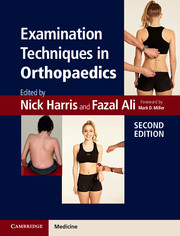Book contents
- Frontmatter
- Dedication
- Contents
- List of contributors
- Foreword
- Preface
- Acknowledgements
- 1 General principles of orthopaedic clinical examination
- 2 Examination of the shoulder
- 3 Examination of the elbow
- 4 Examination of the wrist
- 5 Examination of the hand
- 6 Examination of the peripheral nerves in the hand and upper limb
- 7 Examination of the adult spine
- 8 Examination of the hip
- 9 Examination of the knee
- 10 Examination of the foot and ankle
- 11 Examination of the brachial plexus
- 12 Orthopaedic examination techniques in children
- 13 Examination of the spine in childhood
- Index
- References
3 - Examination of the elbow
- Frontmatter
- Dedication
- Contents
- List of contributors
- Foreword
- Preface
- Acknowledgements
- 1 General principles of orthopaedic clinical examination
- 2 Examination of the shoulder
- 3 Examination of the elbow
- 4 Examination of the wrist
- 5 Examination of the hand
- 6 Examination of the peripheral nerves in the hand and upper limb
- 7 Examination of the adult spine
- 8 Examination of the hip
- 9 Examination of the knee
- 10 Examination of the foot and ankle
- 11 Examination of the brachial plexus
- 12 Orthopaedic examination techniques in children
- 13 Examination of the spine in childhood
- Index
- References
Summary
As with the examination of all other joints in the body, a carefully taken and detailed clinical history will often lead the clinician to a provisional diagnosis of the cause of the patient’s elbow problem.
It is important that, as the patient describes the symptoms, the clinician interprets the information in the light of the local anatomy, most of which, because the elbow is a superficial joint, can be palpated and assessed during the examination.
History
It is always essential when taking a history to record the patient’s age, sex and hand dominance.
Age will give an immediate clue as to the likelihood of certain conditions being responsible for the patient’s complaints. For example, osteochondritis dissecans may be the underlying cause of elbow locking in a young patient, whereas the same symptom in an older patient is more likely to be caused by loose body formation associated with degenerative disease.
The elbow may be the first presenting site of rheumatoid arthritis and, since this occurs more commonly in women, the sex of the patient should alert one to the possibility of this diagnosis if the initial symptoms are pain and slight swelling.
- Type
- Chapter
- Information
- Examination Techniques in Orthopaedics , pp. 25 - 41Publisher: Cambridge University PressPrint publication year: 2014



